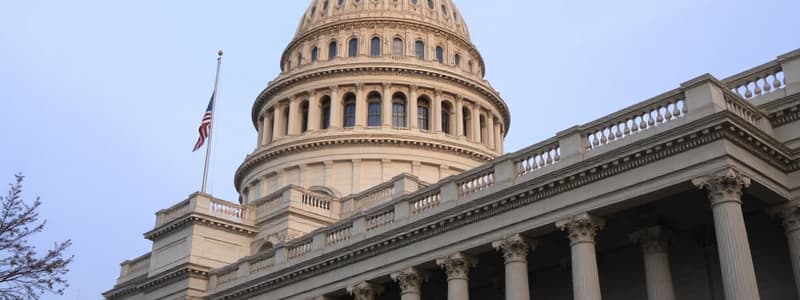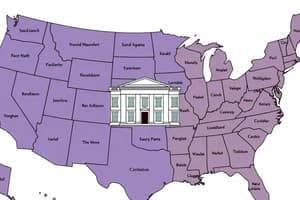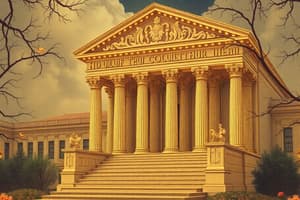Podcast
Questions and Answers
What is federalism primarily characterized by?
What is federalism primarily characterized by?
Which of the following is a responsibility of the national government in a federal system?
Which of the following is a responsibility of the national government in a federal system?
How are the levels of government in a federal system typically structured?
How are the levels of government in a federal system typically structured?
Which characteristic is common in federal systems like that of the United States?
Which characteristic is common in federal systems like that of the United States?
Who leads the federal government in the U.S.?
Who leads the federal government in the U.S.?
What is the purpose of the elastic clause in the Constitution?
What is the purpose of the elastic clause in the Constitution?
Which amendment confirms the reserved powers of the states?
Which amendment confirms the reserved powers of the states?
Which action is explicitly prohibited to the national government under Article I, Section 9?
Which action is explicitly prohibited to the national government under Article I, Section 9?
What effect has the broad interpretation of the commerce clause had on state powers?
What effect has the broad interpretation of the commerce clause had on state powers?
What does the supremacy clause state?
What does the supremacy clause state?
Which of the following states of marijuana legality is accurate?
Which of the following states of marijuana legality is accurate?
What did the Defense of Marriage Act (DOMA) achieve?
What did the Defense of Marriage Act (DOMA) achieve?
What was a major development in government revenue since the early 1900s?
What was a major development in government revenue since the early 1900s?
What percentage of federal revenue in 2020 came from payroll taxes?
What percentage of federal revenue in 2020 came from payroll taxes?
How does the privileges and immunities clause affect non-residents in a state?
How does the privileges and immunities clause affect non-residents in a state?
What is a primary feature of a federal system regarding constitutional changes?
What is a primary feature of a federal system regarding constitutional changes?
Which branch of government holds legislative power in the U.S. at the federal level?
Which branch of government holds legislative power in the U.S. at the federal level?
How do federal and state governments often collaborate?
How do federal and state governments often collaborate?
What is the role of the U.S. Senate in the American federal system?
What is the role of the U.S. Senate in the American federal system?
What was a significant drawback of the Articles of Confederation?
What was a significant drawback of the Articles of Confederation?
What accounts for approximately 72 percent of tax revenue for local governments?
What accounts for approximately 72 percent of tax revenue for local governments?
Which of the following states does NOT impose individual income taxes?
Which of the following states does NOT impose individual income taxes?
What was the primary funding source for state highway transportation projects?
What was the primary funding source for state highway transportation projects?
In the 2019 federal budget, which category received the highest allocation of funds?
In the 2019 federal budget, which category received the highest allocation of funds?
During the Great Recession, what type of federal assistance increased by roughly 33 percent?
During the Great Recession, what type of federal assistance increased by roughly 33 percent?
What was the outcome of McCulloch v. Maryland regarding Congress's authority?
What was the outcome of McCulloch v. Maryland regarding Congress's authority?
What principle was established by the Supreme Court's ruling in McCulloch v. Maryland?
What principle was established by the Supreme Court's ruling in McCulloch v. Maryland?
In Gibbons v. Ogden, what was the main issue that the Supreme Court addressed?
In Gibbons v. Ogden, what was the main issue that the Supreme Court addressed?
What historical event led to the creation of the Second Bank of the United States?
What historical event led to the creation of the Second Bank of the United States?
What was the stance of the Kentucky and Virginia legislatures regarding the Sedition Act?
What was the stance of the Kentucky and Virginia legislatures regarding the Sedition Act?
What was a key reason for the Supreme Court's ruling against the Bakeshop Act in Lochner v. New York?
What was a key reason for the Supreme Court's ruling against the Bakeshop Act in Lochner v. New York?
What was a significant outcome of the New Deal programs proposed during the Great Depression?
What was a significant outcome of the New Deal programs proposed during the Great Depression?
How did cooperative federalism differ from dual federalism?
How did cooperative federalism differ from dual federalism?
What prompted Roosevelt to propose a court-packing plan in 1937?
What prompted Roosevelt to propose a court-packing plan in 1937?
Which of the following significant programs was NOT initiated during the Great Society era?
Which of the following significant programs was NOT initiated during the Great Society era?
What was the primary reason South Carolina initiated the nullification crisis in the 1830s?
What was the primary reason South Carolina initiated the nullification crisis in the 1830s?
What significant action did President Jackson take in response to South Carolina's Ordinance of Nullification?
What significant action did President Jackson take in response to South Carolina's Ordinance of Nullification?
What was one of the key outcomes of the Civil War in relation to state and national government power?
What was one of the key outcomes of the Civil War in relation to state and national government power?
Which federal act was passed in response to anticompetitive practices in the railroad industry?
Which federal act was passed in response to anticompetitive practices in the railroad industry?
What was the outcome of the Supreme Court case United States v. E.C. Knight regarding federal regulatory authority?
What was the outcome of the Supreme Court case United States v. E.C. Knight regarding federal regulatory authority?
Flashcards
Federalism
Federalism
A system of government where power is shared between a national government and regional governments (like states).
National Government Responsibilities
National Government Responsibilities
The national government is responsible for broad issues affecting the entire country, like national defense, economic growth, and international relations.
State Government Responsibilities
State Government Responsibilities
State governments focus on issues within their specific regions, such as education, healthcare, public safety, and transportation.
Democratic Election and Constitution
Democratic Election and Constitution
Signup and view all the flashcards
Cooperation Between Levels
Cooperation Between Levels
Signup and view all the flashcards
Federal System
Federal System
Signup and view all the flashcards
National Constitution
National Constitution
Signup and view all the flashcards
Devolution
Devolution
Signup and view all the flashcards
Unitary System
Unitary System
Signup and view all the flashcards
Confederation
Confederation
Signup and view all the flashcards
What is the Necessary and Proper Clause?
What is the Necessary and Proper Clause?
Signup and view all the flashcards
What is the Tenth Amendment?
What is the Tenth Amendment?
Signup and view all the flashcards
What is the Supremacy Clause?
What is the Supremacy Clause?
Signup and view all the flashcards
What is the Commerce Clause?
What is the Commerce Clause?
Signup and view all the flashcards
What are Concurrent Powers?
What are Concurrent Powers?
Signup and view all the flashcards
Full Faith and Credit Clause
Full Faith and Credit Clause
Signup and view all the flashcards
Privileges and Immunities Clause
Privileges and Immunities Clause
Signup and view all the flashcards
Federal Grants
Federal Grants
Signup and view all the flashcards
Payroll Taxes
Payroll Taxes
Signup and view all the flashcards
Sales Tax
Sales Tax
Signup and view all the flashcards
Property Tax
Property Tax
Signup and view all the flashcards
Intergovernmental Grants
Intergovernmental Grants
Signup and view all the flashcards
Federal Budget Priorities
Federal Budget Priorities
Signup and view all the flashcards
Local Government Revenue
Local Government Revenue
Signup and view all the flashcards
Fuel Tax Erosion
Fuel Tax Erosion
Signup and view all the flashcards
Nullification
Nullification
Signup and view all the flashcards
Dual Federalism
Dual Federalism
Signup and view all the flashcards
United States v. E. C. Knight
United States v. E. C. Knight
Signup and view all the flashcards
Commerce Clause
Commerce Clause
Signup and view all the flashcards
National Supremacy
National Supremacy
Signup and view all the flashcards
Implied Powers
Implied Powers
Signup and view all the flashcards
Strict Constructionism
Strict Constructionism
Signup and view all the flashcards
Cooperative Federalism
Cooperative Federalism
Signup and view all the flashcards
Lochner v. New York
Lochner v. New York
Signup and view all the flashcards
New Deal Conflict
New Deal Conflict
Signup and view all the flashcards
NLRB v. Jones and Laughlin Steel
NLRB v. Jones and Laughlin Steel
Signup and view all the flashcards
Federal Power Expansion
Federal Power Expansion
Signup and view all the flashcards




